Last Friday night, the Farr Vintners Sales and Purchasing teams enjoyed a great night out at Medlar Restaurant in Chelsea. It was a very special evening for us as the dinner was organised to mark the retirement of Jonathan Stephens after 22 years at Farr Vintners.
Medlar was a great choice of restaurant. If you don’t know it, the chef, and several of his team, worked at the great Chez Bruce and front of house supremo David O’Connor is an old friend of ours - formerly at The Ledbury, The Square and Chez Bruce.
Jonathan and I first worked together in 1980 (yes, that’s a very long time ago) when I was the van driver for La Reserve and he, as a resting actor, was a part-time salesman in their Marble Arch wine shop. 1980 was a very poor vintage in Bordeaux that should have been drunk up about 20 years ago but, fortunately for us, Jonathan’s first year with Farr Vintners was a great one - 1989. Consequently I decided that the theme for the night was to be the 1989 vintage and I managed to find 18 bottles from this great vintage (well there were 12 of us!).
We kicked off the evening with some “interesting” white wines before moving on to some altogether more serious and classic reds.
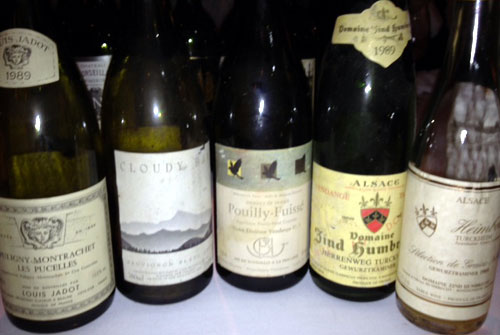
The white wines
|
First up was a pair of Zind Humbrecht 1989s. I remember drinking lots of the regular Gewurztraminer 20 years ago and being surprised at how golden the colour was then. Well, surprise surprise, it’s still the same gold colour with the same low acidity and still has a lovely nose of lychees. On the palate there are flavours of Turkish Delight and rose petals. It hasn’t aged as much as I expected but it is, obviously, starting to fade now. It’s been a joy to drink from the moment it was released and this was my very last bottle.. Much more serious, complex and viscous was the Gewürztraminer Herrenweg Turkheim Vendange Tardive. This was still rich and complex with a lovely perfumed nose and more depth, sweetness and concentration than the regular cuvée. You could serve this as a dessert wine but it worked really well as an aperitif. Still at its peak, this is a classic VT that should still perform well for a few more years. The lack of acidity doesn’t seem to have been a problem at all.
Next up, I bowled a real googlie. I’ve been a fan of New Zealand wines since I first went there in 1990 and, for some reason, I kept a bottle of one of the first vintages of the ground-breaking Cloudy Bay Sauvignon Blanc from Marlborough. Obviously this 1989 was well past its best and only our champion blind taster, Thomas Parker, correctly identified it as a Sauvignon Blanc. This wine had a slightly oxidative nose, but through it was a hint of tinned asparagus and a clinging, grassy, herbaceousness. This followed through onto a nutty asparagus palate which had a candied note on the finish. Certainly an interesting bottle to taste but nobody actually liked it!
After that tricky white wine I next served a classic pair of mature White Burgundies – The Puligny Montrachet les Pucelles from Louis Jadot was getting on a bit and had certainly seen better days. Low acidity, a bit flabby and starting to oxidise. Much better, and really rather impressive was a Pouilly Fuissé from Domaine Guffens (his 10th vintage). This had a fully mature and creamy nose, honeyed peaches and cream. The palate was buttery but still had a backbone of acidity that lifted honeyed and nutty flavours which carried through to a strikingly good finish. This was a really fine mature white Burgundy and I have lost count of the amount of times that a Guffens Pouilly Fuissé has beaten a prestigious name from the Côte de Beaune in one of our blind tastings.
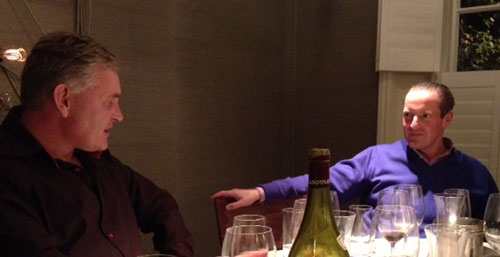
Jonathan Stephens and Tom Hudson
|
The first pair of red wines was from the Rhône Valley. Château de Beaucastel 1989 is a wine that I know very well. We sold masses of it en primeur in 1990 at £70 per case (those were the days). It’s a dirty old wine but I still love it. There are notes of sweaty horse saddles, barbecued meats, forest floor, garrigue and earth. It is a real “animal” of a wine with a touch of brett, but it’s wonderfully complex and constantly changing. At the time it was regarded as the one of the finest Beaucastels ever but I think that the 1990 is now a better wine and one day the 2007 will be regarded as the greatest of all (with 2010 and 2001 not far behind). The Beaucastel was out-trumped, however, by a sensational magnum of Crozes Hermitage Thalabert 1989 from Paul Jaboulet Ainé. Despite the age, this was still black in colour (far deeper than the Beaucastel) with the unmistakable nose of pepper, bacon fat and wild herbs of classic Northern Rhône Syrah. The palate revealed barbecue flavours with oriental spices, dark chocolate, espresso coffee and “steak au poivre”. The tannins are still firm and structured. This is a serious, dense wine that is certainly one of the finest Crozes Hermitages that any of us had ever tasted. It was even better, and younger-tasting, than a bottle of Hermitage La Chapelle 1989 that I had recently at Beaugravière. It is a shame that the run of great Thalaberts that Jaboulet made until the early 1990’s came to such a sad end. I hope that the new owners can revive the quality, they will be doing well to get it back to this level.

Langoa Barton and Grand Puy Lacoste
|
We then moved on to Farr Vintners “home territory” – Bordeaux. The first pair was Langoa Barton v Grand Puy Lacoste. These are two under-estimated and under-priced wines from this great vintage. Both have Parker scores in the 80’s and can be found for under £70 per bottle. The Langoa had a medium colour but fine, ripe Cabernet Sauvignon fruit with mint and cigar box flavours. A classically structured claret with impeccable breeding and balance. Whilst not being a blockbuster, this was a fine glass of wine and a genuine “old school” Bordeaux with good fruit, grip and a full finish. The Grand Puy Lacoste was good, but perhaps a little lean. This is one Château that undoubtedly did better with its 1990 (which is fabulous). This 1989 had some graphite and eucalyptus notes on the palate but could have done with a bit more weight. A dry edge makes it more of an “Englishman’s lunchtime claret” rather than a wine to impress in a blind tasting. Good but not great.
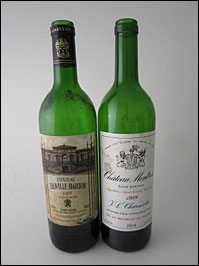
Léoville Barton and Montrose
|
The next pair was Léoville Barton v Montrose. The Léoville Barton 1989 is an absolutely classic Médoc. It still has a deep, black colour with lots of firm and spicy cassis fruit. Plenty of ripe tannins to match. This is a real mouthful but it has great elegance and class. Perfect to drink now. Rich but dry, opulent but finely structured. The Montrose 1989 has always been a favourite of ours and a wine that is frequently as good as the much more famous (and expensive) 1990. Today’s bottle was rich, sexy and full of ripe fruit (very un-Saint Estèphe really). The palate had masses of blackcurrant and leather flavours with a lovely plumpness and a long finish. Quite decadent but still classically Bordeaux. A really great wine.
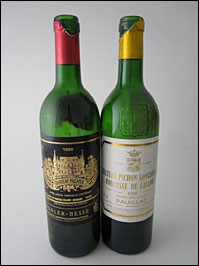
Palmer and Pichon Lalande
|
This was followed by Palmer v Pichon Lalande. I put these two together as they both have high percentages of Merlot in the blends. The Palmer had a medium colour and although showing signs that it was fully mature, there was a lovely smoothness in the mouth with a finely polished texture. Not intense but medium weight fruit and maybe just a hint of leafiness. Good, a little light and lean. Fine but not a great wine on this showing and hard to justify the price or the 95 point Parker score. The Pichon Lalande was better. Lovely and plump with a creamy mouth-feel. It could easily have passed for a Pomerol. Soft, silky and smooth. A really generous and pleasurable wine that has no hard edges and a lovely texture.
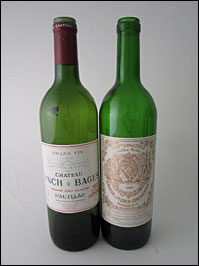
Lynch Bages and Pichon Baron
|
We then moved on to two classics of the vintage that really delivered First Growth quality (in fact these are better than any Médoc First Growth in my view). Pichon Baron v Lynch Bages. Two wines made by the great Jean-Michel Cazes. The Pichon still has a dark colour with black cassis fruit. Sweet and ripe with fabulous intensity yet real Bordeaux structure and breed. Dark and brooding tannins match the plummy richness of fruit. Great balance. Serious and a truly great bottle of Bordeaux. The Lynch Bages fought it all the way. This wine is the essence of cassis with hints of mint and cigar box. Maybe a bit silkier than the Pichon and not quite as dense. So classically Pauillac and pure. A gorgeous wine that on its day is close to perfection. This was merely a very good bottle and I scored it half a point behind the Pichon. It was a close race with a photo finish.
For the final pair we moved to the Right Bank. La Conseillante v Le Tertre Roteboeuf. The La Conseillante has a maturing colour that suggests a wine on the way out. Not at all. This is a sensationally succulent wine with a fabulous creamy texture. Full of ripe plummy fruit. It is beautifully silky and polished and very much an iron fist in a velvet glove. Soft and delicate yet intense and long. This is what Pomerol is all about. The Tertre Roteboeuf was a less good bottle than one we enjoyed at the Château earlier in the year. It was sweet and powerful but the alcohol was too noticeable and it was, perhaps, a touch volatile. Big, impressive, but hot and firey. A powerful wine that didn’t seem to be quite on song. I’ve had much better bottles of this before.
Our final wine was the very rare Gewurztraminer Heimbourg Selection des Grains Nobles from Zind Humbrecht. This was a huge step up in concentration from the VT version that we had earlier on. Incredibly sweet with amazing , soaring aromatics. The essence of lychee with raisin-like sweetness. Very impressive and almost too much. Huge wine. Impressive but some found it a bit overwhelming and heavy.
It was certainly a great night and, we hope, a fitting send-off to Jonathan as he enjoys what will be a very long and (if I know him) a very gastronomic retirement from the every-day business of the wine trade. I look forward to sharing many more bottles with him in the years to come. I’d like to thank him for his enormous contribution to Farr Vintners over the last 22 years and for choosing to join us in such a brilliant year as 1989!
My Scores on the Night: